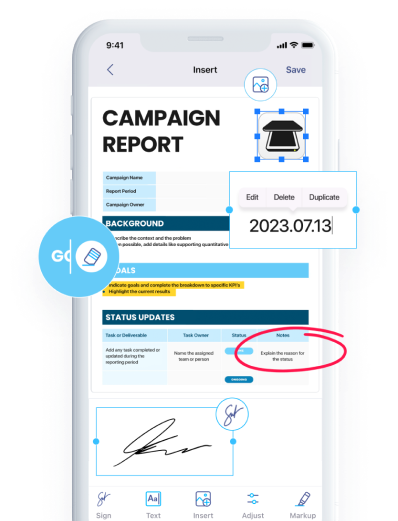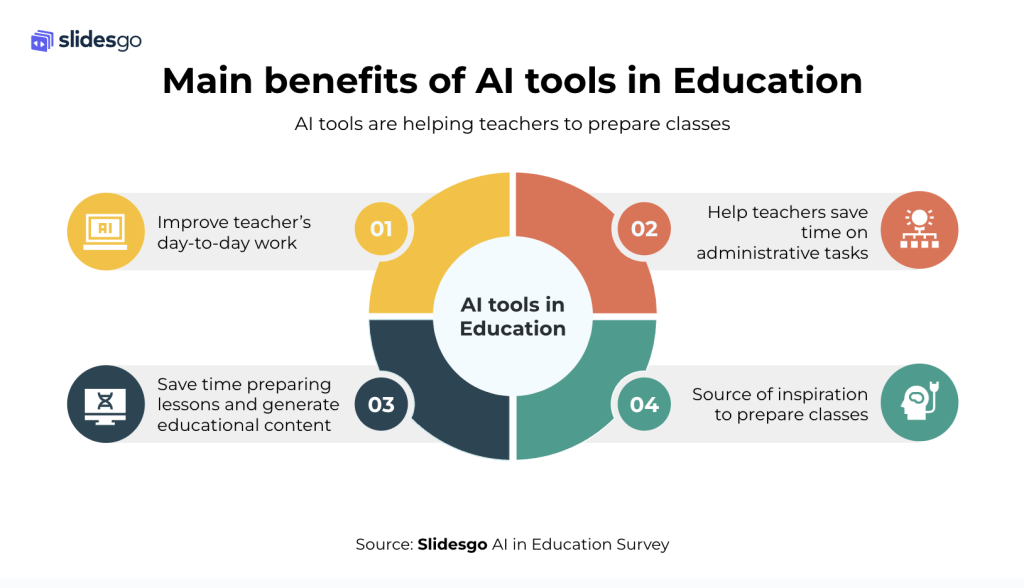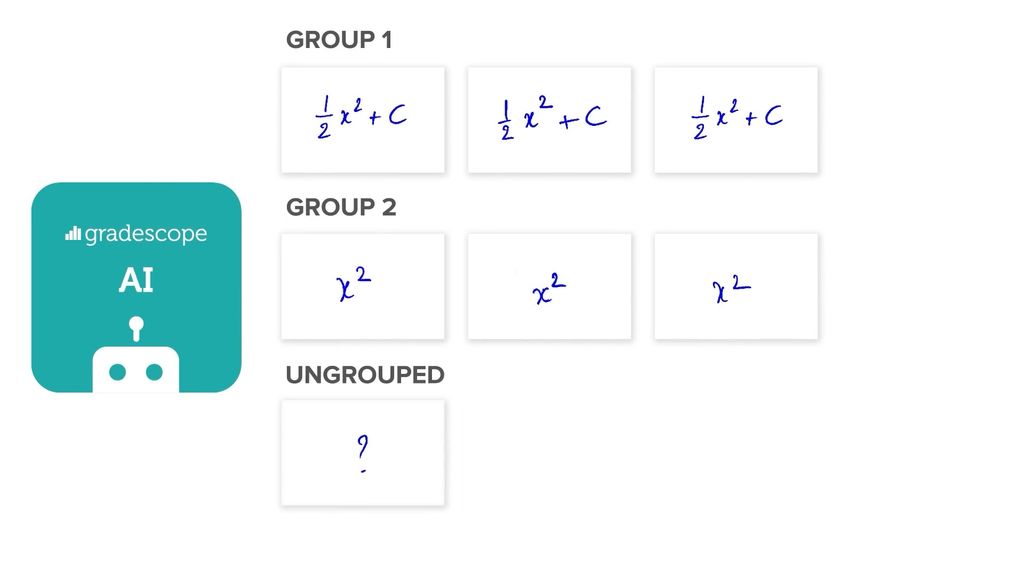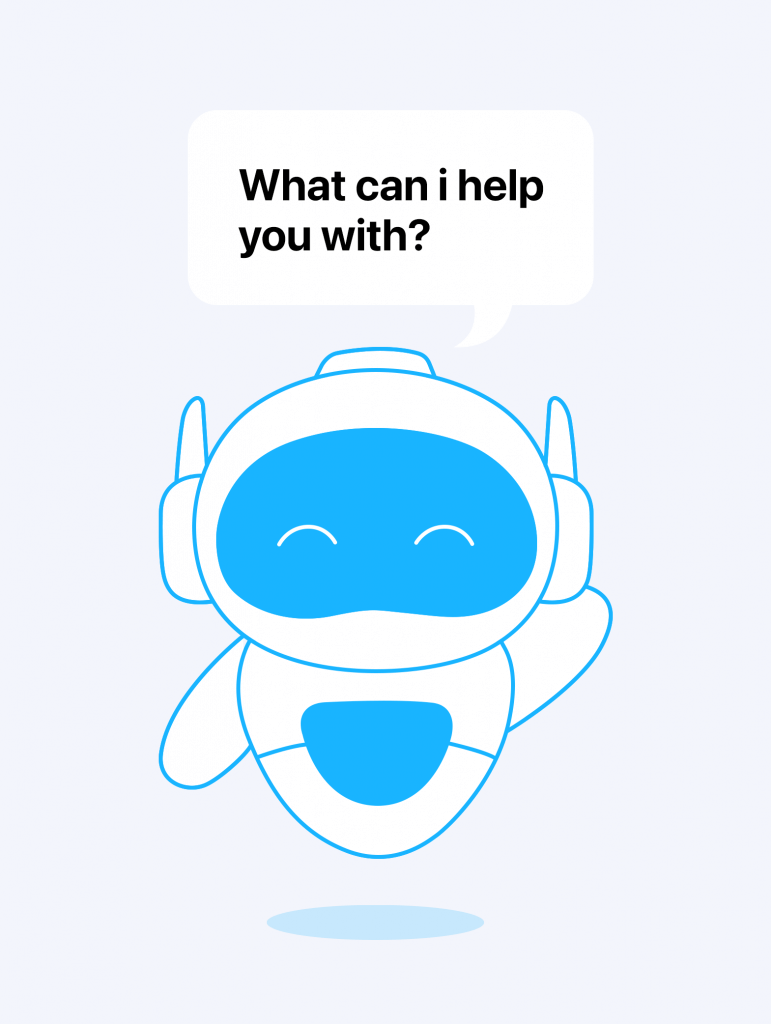

15 aug 2022
When it comes to AI, you usually get two extremes. On the one hand, you get people saying that artificial intelligence is still useless, and on the other, there are people spreading the idea that AI is dangerous and will one day destroy humanity. We think AI technologies are neither. Instead, a productive way to approach AI educational tools is to see them as helpful assistants that can take over time-consuming, repetitive, and trivial tasks.
According to the 2023 American Teacher Survey, paperwork and other tedious administrative tasks rank third among the primary causes of job-related stress for teachers (incidentally, that’s higher than salary dissatisfaction). The survey findings also highlight that this factor is particularly stressful for younger educators, signaling a concerning trend for management. Plus, Slidesgo has done some interesting research on how teachers view AI tools for education—their survey shows that over 70% see AI as beneficial for education.

A majority of educators, even if they are most devoted to their profession, don’t enjoy grading. It’s tedious, repetitive, and incredibly time-consuming. Depending on the subject they teach, some (English and math teachers prominent among them) have to spend up to 30 hours a week grading papers. This greatly contributes to job dissatisfaction among educators and only exacerbates severe staffing problems.
The good news is that there are educational AI tools that can help with grading. Although grading software is still in its infancy, some applications can already reduce time spent grading by 100%! In China, for example, around 60,000 schools have already implemented an AI-based grading system, according to the South China Morning Post.
Here are some examples of AI tools that can help.

Gradescope can’t do all the marking for you yet, but it has a very clever approach that can cut grading time in half. The process looks like this: students’ assignments are scanned and uploaded to Gradescope for text recognition and analysis, and the app identifies identical or similar answers and groups them. The teacher then only has to grade each group of answers rather than having to go student by student. For example, if 100 students take a quiz of 10 yes/no questions, the teacher will only have to grade 20 groups of answers. This is a simplified scenario because quizzes usually have a lot of multiple-choice questions, but you get the idea.
AI essay graders: Grammarly, Paper Rater, and more. Grading essays is probably one of the most time-consuming and complicated grading tasks. A good essay is not only about eloquence, good grammar, and syntax, although these are crucial too. Apart from having a comprehensive understanding of the academic field, teachers need to assess how well students can justify, explain, present information, draw conclusions, and understand their audience. Such assessments are so complicated and multilayered that no AI tool can cope with them. However, AI tools can identify multiple mistakes of a simpler nature and even check for plagiarism. It significantly facilitates grading and lets teachers focus on more complex and fundamental problems with their students’ writing. Some tools like Paper Grader or AI Grader can even learn your grading metrics. You would need to upload a lot of graded assignments to train the software, but it can be worth it in the long run.
The amount of paperwork that modern teachers have to deal with is huge. It’s not unusual for a teacher to arrive at school an hour early just to print out and scan what they need before it gets busy or printers run out of paper. Having highly trained, skilled educators spend their time printing is like using a laser to make a grilled cheese sandwich. Therefore, switching to a digital workflow whenever possible is very much in the public interest. Environmental issues aside, it can free up teachers’ precious time for actual educating. Luckily, there are plenty of AI-powered tools that can drastically reduce the amount of paper and make document workflow seamless without the need for a printer or scanner.

iScanner is an AI-based document management app available both on iOS and Android devices. Apart from being a powerful mobile scanner, it has a whole tool kit that covers everything you could ever need to work with documents. Editing, text recognition, e-signatures, commenting, adding text, watermarks, vector graphics, and so much more. On top of that, the app has a well-designed file management system and lets you easily share documents via Google Classroom, Canva, email, or any messenger. With an app such as iScanner, assignments can be shared digitally with the class rather than printed and then collected, marked, and returned to students the same way. Students can also benefit from using iScanner for their assignments.
Even with a digital workflow in place, you still get a flow of documents. They need to be organized in your digital storage, and that’s not an easy task. ABBYY FlexiCapture can be of great assistance with this. This AI-based software can be trained to recognize and group different types of documents such as assignments, student progress reports, various logs, and charts. It can also quickly extract data for further analysis, which facilitates reporting.

Answering students’ questions is surely one of a teacher’s main responsibilities. It’s great when students engage and ask lots of deep questions because it’s a chance for them to grasp the material much quicker and for the teacher to pinpoint what they struggle with most.
Unfortunately, the majority of questions that teachers have to answer regularly concern schedules, admission processes, and various school forms, and they are repetitive, especially when it comes to the enrollment process. For instance, among the colleges that received the most applications in 2020, the average number of applications was 85,000. Naturally, the number of queries can become overwhelming. It makes perfect sense to reassign this tedious process to an AI assistant and let teachers deal with more difficult questions only they can answer. Modern AI chatbots are more than capable of answering repetitive questions, and that’s not all they do.
This is a chatbot that you can train to answer frequently asked questions. This bot can post images and links as well as text. What’s more, it can also ask students questions and collect their responses along with contact information.
This bot can do everything listed above and can also be of great help with onboarding students, learning processes, and assessment. It can recommend courses and send reminders and is pretty quick to set up.
Designed by a certified psychologist, its AI algorithm is trained to provide emotional support through conversation. First-year students can feel overwhelmed with coursework and alienated because most have to move to a different city to go to a university or college. Students not getting the support they need is believed to be the main reason for dropping out. Quite often they simply don’t have anyone to talk to, and this tool can help in such situations.
Creating an engaging and effective learning environment is challenging enough. However, most students with special needs require personal assistance, or they might lag behind others. Creating an inclusive classroom may be a problem, especially given the staffing shortages.
AI technologies can become an invaluable tool for inclusive education. Thanks to AI-powered software, dyslexic students can transfer text to voice in seconds, and students with impaired hearing can get subtitles to any video material. The already mentioned chatbots can be of great help to such students when they feel too embarrassed to ask their teacher or peers for help.
This app can create voice-to-text transcriptions in real time! It’s a truly amazing AI-based tool that makes it possible for students with hearing impairments to understand lectures. The app can also create detailed notes of a lecture or presentation for future reference.
Lookout is a mobile app by Google that provides visual aids for visually impaired people. The app will tell you what you’re looking at in real time when you point the camera at something. It can also read documents. Users can switch between three different modes—work, play, and home—which greatly increases the accuracy of recognition.
Thistext-to-voice application can be a big help to anyone who has difficulty reading. It lets you lean back and listen rather than having to peer into a textbook. It’s a great tool not only for visually impaired people but also for those with ADHD and dyslexia.
In summary, AI in schools has great potential to become a true game changer. Modern tools can free up teachers’ time for what is really important and give students support every step of the way. According to eLearning Industry experts, over 47% of education management tools will be replaced by AI-powered ones within just a couple of years. This means that in the next 5 to 10 years, we’re going to observe an upsurge in the number of startups that will take education to a whole new level and make the process easier both for students and educators.
